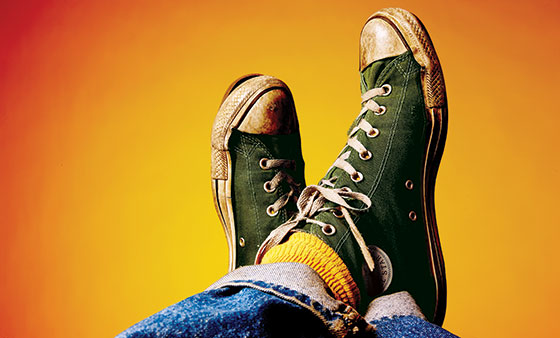 |
(Photo: Bobby Doherty/New York Magazine) |
It’s not that New York has become any less chaotic, but amid the relentless hustle is a recent move to nada-hood: In the past year, dozens of apps have popped up that make social interaction and trips to Duane Reade less and less necessary. Need toilet paper delivered in an hour? Press a button. Too tired to mop your floors? Enlist the latest iRobot. But why stop there? For when TV plots seem too complicated, Candy Crush too physically taxing, and the newspaper just too damn wordy, there’s now an ever-more-passive alternative. So whether you want to avoid dirty dishes, the treadmill, or your friends, here’s a guide for living your laziest life.
How to Not Socialize
Peter “No Show” Davis, the publication director of fashion site the Daily Front Row, explains how to gracefully cancel plans.
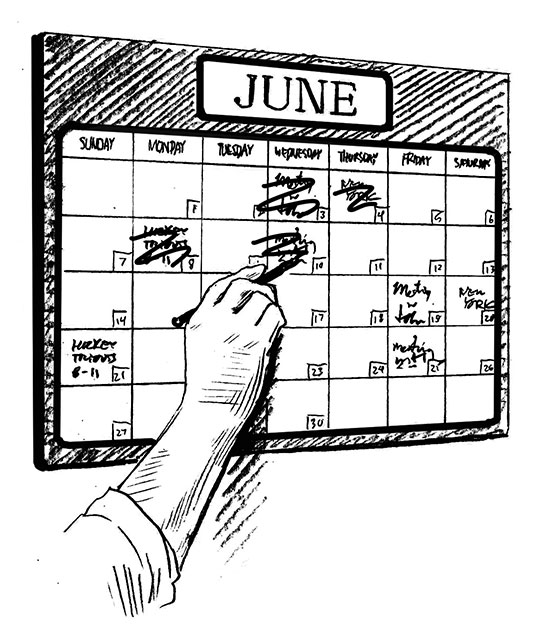 |
Illustration by Joe McKendry
|
A week in advance: “The best way to blow someone off is to just keep rescheduling. Start days or weeks in advance and cancel with different excuses—you’re sick, your dog is sick, you’re taking care of a sick friend. Soon they will leave you alone, because who would ever want to be around so much sickness?”
The morning of: “If I’m going to L.A. on a Tuesday and I want to get out of an event on a Monday, I just say I’m moving my trip up a day. You can use Facebook and other social-media outlets to say something general, like ‘L.A.= Heaven! So happy!’ and really I’m in Williamsburg, in bed, eating pizza, watching True Blood.”
An hour before: “I usually blame work and say that I’m still at the office. If you don’t think they’re going to buy that, I’ll say family emergency, because what does that mean? It could be anything. It could be someone else’s family that’s in trouble. They don’t know. I use it very sparingly and for maximum effect. I don’t like to lie as a rule, but it’s a white lie, because I’m sure there’s some family that needs my help, even if I open the door for a mother and her child. If she is holding a lot of bags, it’s an emergency.”
And how to not show up—without actually canceling: “Last Halloween, Susanne Bartsch made me a host of her HalloQueens! party at MoMA PS1. I tried to put together a costume, and it didn’t work out. Then I walked outside of my building, and there were drunk people everywhere. I was like, I can’t do this. I’m not going out. So I stole a picture of the crowd at the party from Instagram, cropped it a little, and immediately put it on my feed with the caption ‘Most amazing party ever! So many people, head spinning!’ and I used all the party hashtags. That was another white lie, because I didn’t technically say I was there, but Susanne thought I was. She commented, ‘Where are you babe?’ and I wrote back, ‘Where are you? So crowded!’ ”
—By Whitney Spaner
How to Not Socialize at Work
“I sit near people who drive me crazy. So I’ll put on my noise-canceling headphones, and when they start talking, I’ll take walks to remove myself from the random chatter. But what’s really helpful is that I found this empty spot where no one works; it’s like a storage area. I’m willing to plug in there and sit and work in the dark. If someone emails me and says they want to stop by, I say, ‘No, I’ll find you.’ ” —Brian S., statistician, midtown
—As told to S. Jhoanna Robledo
How to Not Watch TV
But still watch TV.
 |
Illustration by Joe McKendry
|
Slow TV is a massive phenomenon in Norway. For the last several years, viewers have tuned in to watch a train chug along on a seven-hour journey or a ship travel down a coastline for five days. And it’s now no longer just for solemn Scandinavians: The Travel Channel will air the first full-on American Slow TV show this November on Black Friday. For those in need of relief from the pressures of the holiday, tune in to watch a 12-hour car trip—destination TBD.
—By Alex Yablon
How to Not Wash …
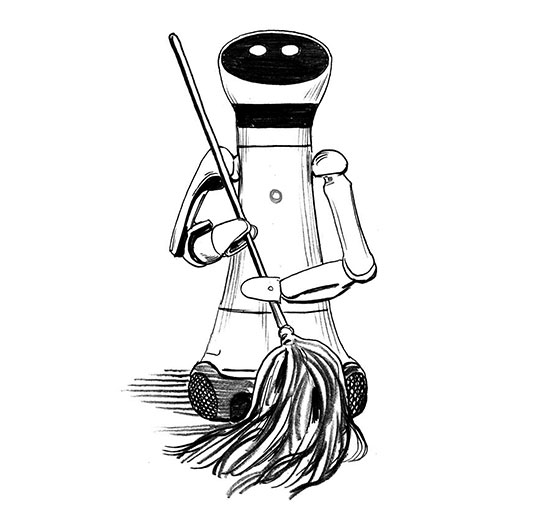 |
Illustration by Joe McKendry
|
Your Hair:
Little effort: Join the no-poo movement and swap shampoo for cleansing conditioners (this is sometimes also called co-washing) that lift out impurities with gentle moisturizing ingredients such as essential oils and aloe vera (instead of stripping away dirt and oil with surfactants like suds do). Options include Bumble and bumble founder Michael Gordon’s Purely Perfect Cleansing Creme ($40; hairstory.com) or Goldman Sachs VP turned beauty guru Nancy Twine’s Briogeo Be Gentle, Be Kind Co Wash ($20; briogeohair.com). These products also leave the scalp less greasy, freeing you up to wash your hair less often.
No effort: There’s a more sophisticated alternative to your standard dry shampoo that requires just as little arm movement. The scent of clean hair is subtly diffused throughout the day with a few spritzes of Byredo’s new hair perfumes ($62). The brand’s popular scents (Bal d’Afrique, Gypsy Water, Blanche) include notes of jasmine, violet, bergamot, and neroli. All are available at Byredo’s first U.S. store, which just opened in Soho (62 Wooster St., nr. Spring St.; 212-219-1584).
Your Floors:
Little effort: Coat your wood, concrete, or stone floors with the Rust-Oleum NeverWet Multi-Purpose Spray Kit, a super-hydrophobic treatment that repels water, mud, ice, and other liquids (it causes the liquids to form perfect spheres, so they scatter instead of puddle, and prevents the wear and corrosion that comes with moisture). Spray on two coats, one initial blast followed by a top coat; it’ll be spill-resistant the next morning ($17; homedepot.com).
No effort: The fast-charging iRobot Braava 380t Floor Mopping Robot (an evolution of the beloved vacuum by the same brand) is guided via GPS to wipe up dirt, hair, and dust from any hard-surface floors, including vinyl, wood, and laminate, using an attached dry or damp cleaning cloth ($300; amazon.com). Those with a few hundred grand to spare might consider the life-size Care-O-bot (care-o-bot-4.de), a service robot designed to help humans clean the kitchen, among other household tasks.
Your Clothes:
Little effort: It’s a big investment, but you’ll spend less time in the laundry room: The LG Styler (introduced at this year’s CES; $2,000 at Pirch in Secaucus, N.J.; 551-999-6540) is a “clothing refresh” machine that looks sort of like a refrigerator. Simply hang your clothes inside, and it’ll shake out wrinkles, steam away odor and dust, and leave a light, clean-smelling scent on up to five pieces at a time (it can also de-crease slacks). No spin cycle or detergent required.
No effort: Elizabeth & Clarke’s Unstainable White Shirt, which comes in various blouse styles, has a nanotech coating of hydrophobic material that repels “virtually any water-based or oil-based liquid spill.” And, yep, this includes sweat. The Kickstarter-backed company has already made a name for itself with tops that cap at $30, and while the Unstainable White Shirt won’t yet deflect lipstick stains, it will block errant wine, coffee, or salad dressing (available to pre-order in July; unstainable.ec).
—By Kayleen Schaefer
How to Not Get Out of Bed
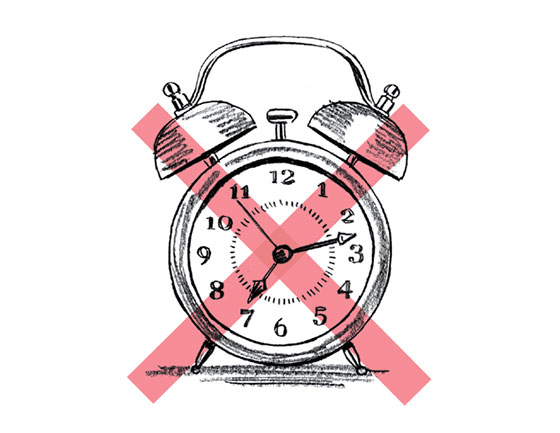 |
Illustration by Joe McKendry
|
“My girlfriend usually gets up first to go to work, and what’s dreamy and sweet is that she’ll put a shirt over my eyes to let me stay in the zone. We call it ‘the blindfold.’ She’ll crawl over me to get out of the bed, and I continue enjoying my sleep. I get up around ten on my own—during the spring, the window is open, and the sun comes through these big windows, and waking up is a natural thing. I stay in bed for about two or three hours, reading recipes or checking out food videos on YouTube to plan out things I may want to cook or test out during the day, since I’m doing some chef-apprenticeship work at nights. I look on Twitter and see what’s up with the developers I follow, then do some coding. Like recently, I designed and coded a website for a local jazz band. I just can get right into a productive rhythm while still in bed.” —Derek Lucci, designer, Williamsburg
—As told to Margaret Rhodes
How to Not Hear Your Neighbors
It’s not pretty. But it works.
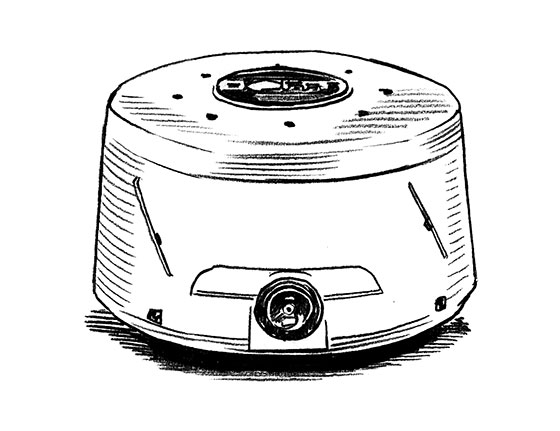 |
Illustration by Joe McKendry
|
If the same product has survived and thrived on the market for more than 50 years without any substantive changes, it’s probably onto something. Take the Marpac Dohm white-noise machine ($48 on amazon.com), which first hit nightstands in 1962. Even in an age of white-noise apps and high-tech digital devices, this Mad Men–era throwback is, remarkably, still the best noise machine on the market. The beauty of the Dohm, which resembles an oversize smoke detector, is that its operation is purely mechanical: There are no companion apps (which are often interrupted by incoming phone alerts) or looping digital audio files (a feature that causes some noise machines to be a bit distracting when the loop resets). Instead, a physical fan blade makes whirling waves that effectively mask the sounds of the city and soothe you to sleep. Its output is less harsh and more natural-sounding than that created by digital devices, and its controls are almost atavistic in their simplicity: The on switch has two speed settings, and twisting the top slightly changes the sound. That’s it.
—By Seth Porges
How to Not Think
Transcendental Meditation on the C train.
By David Marchese
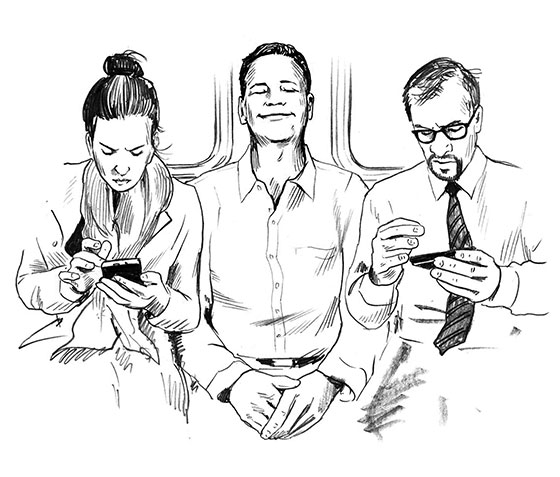 |
Illustration by Joe McKendry
|
A great many extremely successful and presumably fully actualized people, from billionaire hedge-funder Ray Dalio to pop goddess Katy Perry, are advocating these days for the life-changing benefits of Transcendental Meditation. TM, they say, will sharpen your decision-making, unlock your creativity, amplify your you. Science is also onboard. Studies suggest that TM practitioners are at reduced risk for heart attack and stroke. All this from just sitting there and focusing on your secret mantra. When I mention this sort of stuff to people—I’ve been doing TM for six or so years—I normally get an interested nod in return. When I say it involves meditating twice a day for 20 minutes a pop, the nod turns into something more skeptical. Where am I supposed to find the time?
I find it on the C train. As long as your commute is long enough, the subway offers a great opportunity for achieving profound inner stillness. First off, you need to find a seat, which is why I opt for the less crowded local, rather than express, train. Then, with your back straight, head tilted slightly down, and eyes closed, do about 30 seconds of deep breathing before you begin silently repeating your mantra—the secret word, supposedly custom-chosen, that your TM instructor (find a nearby class and instructor at tm.org) will have given you. Don’t try to clear your mind, just favor the mantra. Repeat it. Keep repeating it. Favor it above all other thoughts and sensations. If other thoughts do bubble up—and they will—just come back to the mantra. You’ll be amazed how quickly the ambient MTA blare fades away as you transcend toward pure consciousness. A sort of whole-body inner joy takes over, as if your heart were gently laughing. Hard-core TMers say 20 minutes is mandatory—I use the timer on my iPhone—but if you’re diligent about the mantra, you can transcend after a few minutes, so it’s okay if the train starts running express. Even ten minutes of TM is a nice psychic boon, and, I promise, infinitely more satisfying than another level of Candy Crush.
Four Other Places to Turn Off and Tune Out
Ziva Meditation
“Meditation was behind this shroud of mystery and incense for so long. Now neuroscience is catching up, and that’s bringing Google execs, Tony Award winners, and the Sweetgreen founders to our classes,” says Emily Fletcher, who opened Ziva Meditation in 2012. Fletcher skips the usual Buddhist teachings in favor of Vedic meditation—a 20-minute, twice-a-day solo practice—in four-day intro sessions of guided meditation and Q&As. It’s designed to quiet neuroses of all kinds. $100 a month for an 11-month membership; 252 W. 38th St., Ste. 306.
Sound Bath at Maha Rose Center for Healing
Once a month, a music psychotherapist here uses tuning forks to play quartz-crystal singing bowls for two hours while two dozen people lie on thick serape blankets, just listening. The acoustic vibrations reverberate through your body, bringing you to an alpha state close to the edge of sleep or a theta state of near-psychedelic seeing. Sound baths are said to cure everything from stress to tinnitus. Owner Lisa Levine calls it a reset, like “rapid meditation.” $25 per sound bath; 97 Green St., No. G3, Greenpoint.
Vibrant Sea-Flotation Therapy
There’s 900 pounds of medical-grade Epsom salt in the stainless-steel flotation-tank chamber at Vibrant Sea, which opened last November. That salt pulls double duty: It lets you float in one foot of water (“Like the Dead Sea in a box, but cleaner,” says co-owner Christina Pistone) in total darkness, depriving your senses of any stimulation, so you can slip into a deep meditative state. The salt also alkalizes your blood and cleanses your liver, making one hour in the tank feel like three hours of sound sleep. $90 for a one-hour session; 528 E. 5th St.
Blue Cliff Monastery
Life slows down at Blue Cliff Monastery, a farmhouse-style mindful-retreat center tucked away in the Catskills. Monks, nuns, and visitors (there’s room for 75) follow the monastic schedule: Rise at 5 a.m.; bamboo-stick stretching exercises at 7 a.m.; and a mix of sitting and walking meditation until 9:30 p.m., when the no-talking “noble silence” kicks in. Even during the day, there’s little chatter: Blue Cliff frowns upon electronic gadgets and encourages guests to take (vegan) meals in silence, chewing slowly and thoughtfully. From $40 a night; bluecliffmonastery.org.
—By Margaret Rhodes
How to Not Sweat
Lower and lower impact workouts.
 |
Illustration by Joe McKendry
|
ModelFit Sculpt
modelfit.com
Founder Justin Gelband focuses on small muscles (the teensy ones around your butt, thighs, abs, and arms) and equally small movements. In the hour class, the exercises (done with bands or light ankle weights) include tiny crunches, planks with barely lifted legs, and—perhaps the most you’ll sweep your limbs—standing rows with a band.
Low impact
RX Series
equinox.com
This rest-and-recovery class is meant to accompany a strenuous workout, but you could skip the strain and go straight to the recovery. The sessions are dedicated to self–myofascial massage (kneading the soft tissue to relax contracted muscles and improve circulation) and range-of-motion stretches—all done to relieve aches and pains and give you a head-to-toe recharge.
Lower impact
Yoga Nidra
pureyoga.com
Yoga Nidra, which means “yogi sleep,” is done lying down, often using a bolster and/or a blanket. The instructor leads you through a series of steps (for 30 to 45 minutes) designed to induce conscious relaxation (the body feels like it’s sleeping, but the mind doesn’t), all in an effort to free you from tension.
Lowest impact
—By Kayleen Schaefer
How to Not Shop
Apps to deliver what you need—right now.
Toilet Paper
 |
Illustration by Joe McKendry
|
Is it, um, an emergency?
Postmates General Store
Gist: Soap.com-like selections from participating restaurants and its own “general store” of groceries and household essentials.
Time frame: Within the hour.
Fee: $5 and up, based on distance (sometimes affected by “blitz fee” like Uber’s surge pricing); 9 percent service fee included.
Radius: All of Manhattan, parts of Brooklyn and Queens.
Ride: Bicycle, car, truck, scooter, motorcycle.
Or can you wait till you get home from work?
Google Shopping Express
Gist: Deliveries made in partnership with participating stores, including mom-and-pop shops as well as national chains.
Time frame: Same day or overnight.
Fee: $10 monthly subscription; no delivery fee for orders over $15. No tipping.
Radius: All of Manhattan.
Ride: Van.
A Dress for a Last-Minute Cocktail Party
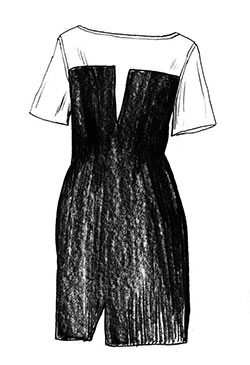 |
Illustration by Joe McKendry
|
Do you want that Phillip Lim sheath you saw in the Barneys window last week?
UberRUSH
Gist: Will pick up any object so long as it’s under 30 pounds. Just drop a pin on the app and include instructions.
Time frame: Pickup guaranteed within minutes; no guaranteed delivery time.
Fee: $4 base, and $1 donation to the Bicycle Messenger Emergency Fund, plus $5 per mile. Tip not included.
Radius: All of Manhattan, parts of Brooklyn, Roosevelt Island, Long Island City, Astoria.
Ride: Bicycle.
Or would you rather someone walk you through the Barneys sale rack over the phone?
Wunwun
Gist: Enter the product you want (and the store from which you want it), and you’ll be connected with someone to get it for you.
Time frame: Within the hour.
Fee: $10 courier charge plus $4 for each “zone hop” between store and destination. Automatic tip adjusted by value of item—it’s $4 flat for items under $20.
Radius: Manhattan below 125th Street, Brooklyn Heights, Williamsburg, Greenpoint.
Ride: Bicycle, car, scooter, motorcycle.
A Nice Piece of Fish
 |
Illustration by Joe McKendry
|
Do you want a fancy chef to cook it for you?
Caviar
Gist: An upmarket version of Seamless that partners with a range of restaurants to deliver the hitherto undeliverable.
Time frame: ASAP, or at a prescheduled time booked up to a week in advance.
Fee: $5 flat delivery charge plus 18 percent tip included.
Radius: Manhattan below 96th Street, parts of Brooklyn.
Ride: Bicycle, car, truck, scooter, motorcycle.
Or would you prefer it raw?
Instacart
Gist: A way for New Yorkers to get the trifecta of ultimate grocery experiences—Fairway, Whole Foods, and Costco—delivered to their doors.
Time frame: Within two hours.
Fee: For orders over $35: $4 for deliveries arriving in two hours or $6 for deliveries within an hour, plus a “busy fee” during times of high demand.
Radius: Manhattan below 153rd Street, all of Brooklyn and Queens, Roosevelt Island.
Ride: Bicycle or car.
And If You Don’t Want to Choose Between Services …
There’s also Magic (getmagicnow.com), which deals with all these delivery services for you (it’s been called “an Uber for Ubers”) and works completely over text message. Customers text requests (for anything that isn’t illegal), and the service operators essentially arbitrage between the different platforms to see which one will get the order done fastest and cheapest.
—By Alex Yablon
A Few Other Things You Can Have Delivered to Your Door
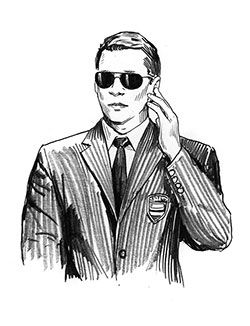 |
Illustration by Joe McKendry
|
A banana before your workout: For $350 a month plus additional fees, SIN Workouts, a “fitness concierge,” not only books clients’ exercise classes but will rouse them at 5 a.m. with a pre-spinning banana.
A running bib: Don’t look like a schmuck at the next 5K. For those showing up to the fun run without that must-have numbered running bib, Bib in a Zip charges $15 and up to stop by runners’ homes. It often coordinates with race organizers to make sure all information on the bib is correct.
An eye test: David Schafran of Blink brings his family optometry business to the Uberized world with $75 eye-test house calls. Manhattanites can book online.
A bodyguard: Bannerman provides licensed security guards for individuals, events, homes, or offices, either within the hour or scheduled ahead of time, booked by phone app for $35 per hour.
A model: Eve, an almost-launched smartphone app, promises to connect models to a variety of clients for $65 to $150 per hour for photo shoots, event “atmosphere,” and anything else, so long as it’s not for a date.
—By Alex Yablon
Not-Activities
Mesmerizing games and pastimes involving one hand or less.
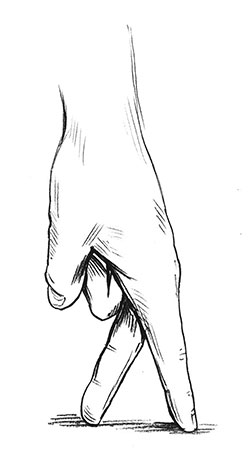 |
Illustration by Joe McKendry
|
No Hands
With so-called zero-player games like Dreeps, all you do is set an alarm on your phone, which awakens a small robot boy who has steampunk adventures in a lovingly imagined fantasy world, fighting enemies and gaining experience while the “player” does nothing but watch his progress ($3 at the app store).
Just Thumbs
While away an afternoon plucking on a mbira, or thumb piano, a small wooden instument from Zimbabwe—easy to play since they are usually already in one key. Whatever you hammer out will sound sufficiently magical ($40 at amazon.com).
One Finger
“Clicker” games like CivCrafter allow you to create a civilization just like one would in the nerdy immersive computer classic Civilization, only this time by clicking on single buttons that determine what forces guide your smartphone society. Watch as your basic decisions snowball into history (free at the app store).
Two Fingers
The appeal of the pinball-like smartphone game ZenDots is not the speed of the action but rather the simple flat-color design and rhythm of falling dots once they’ve been knocked down (free at the app store).
Several Fingers
An upgrade to your classic Silly Putty, Crazy Aaron’s comes in a metal tin, as opposed to those tiny plastic eggs, in an array of novel forms. Squish away at clear “glass” putty, glow-in-the-dark putty, or heat-sensitive color-changing putty ($9 at puttyworld.com).
One Hand
Coloring books for adults are a thing. Johanna Basford’s Enchanted Forest lets grown-ups splash color across intricate inked-outline illustrations of flora and fauna ($11 at barnesandnoble.com).
—By Alex Yablon
How to Not Wear Shoes
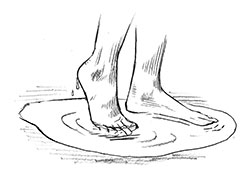 |
Illustration by Joe McKendry
|
“I stopped wearing shoes one February five years ago when my sciatic pain got bad. Going shoeless has actually been an opportunity to embrace a whole new set of stimuli and experiences. When I’m walking on a new surface I’m vulnerable, and all of my senses are involved. My bare feet are helping me to live right here and now. It’s freedom. I love stepping in a mud puddle and feeling the mud squish between my toes. Snow is challenging, but this winter was so cold I learned that 10 degrees or lower is perfect for going out in nothing but dry, heavy wool socks. I now have a new way of experiencing the world.” —Carrie Deweese, U.S. Army Veteran, Rexford, New York
—As told to Margaret Rhodes
How to Not Have a Cell Phone
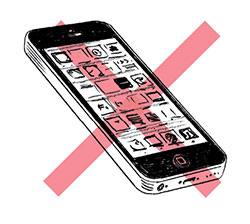 |
Illustration by Joe McKendry
|
“I never actually set out to be the no-phone guy, but I was always losing my gadgets, and it taught me something: Without a phone, I always had an excuse to be a flake, without taking on any of the blame myself. So it eventually became a choice. Now I find other ways of staying in touch with people: I simply drop by. I happen to know the codes to most of my friends’ buildings, which allows me to buzz myself in and show up at their door. If I see something on Facebook that is intriguing, I make a note of it, and if I’m out and about, I’ll go. Most of the time friends have no clue that I’m going to their events—it sort of just happens. In the rare instances when I do need to place a call—mostly for work-related reasons—I find a Wi-Fi hot spot and use Talkatone and Google Hangouts. The only times when it’s annoying are when I’m looking for a good vegan restaurant nearby—that’s pretty impossible without preplanning.” —Preston Charles, TV producer, Bushwick
—As told to Seth Porges
How to Not Read the News
What it is: Paste article URLs into Speaky ($4) and the app will read the news aloud as you rest your screen-weary eyes. Speaky displays the amount of time it will take to reel off each article, along with a ticker tracking Speaky’s progress word by word, which you can toggle backward and forward.
When to use it: Articles in your Speaky queue play without an internet connection, so you can breeze through a New Yorker treatise as you ride the subway or catch up on world news on your next international flight. “People use the app in ways I never anticipated,” says creator Sandratra Razafindralambo; Speaky has been recommended to dyslexics, visually impaired users, and language teachers to demonstrate pronunciation.
Added perk: You can even give Speaky a female South African accent, which will make that David Brooks column a whole lot sexier.
—By Samuel Anderson